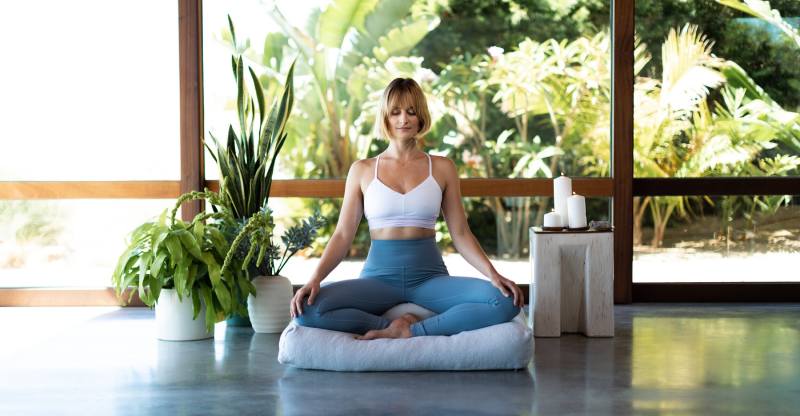Despite the fact that our houses are already havens of tranquility and personal refuge, there isn’t usually a designated area for practicing mindfulness. While we have rooms for all of our fundamental activities—a kitchen for cooking, a bedroom for sleeping, and a living room for relaxing—it only makes sense to have a separate area for daily exercise and meditation. You can build a more dependable pattern by creating this space in the comfort of your own home just for practice and mindfulness.
It can be challenging to mimic the vibe and environment of a yoga studio, yet there is beauty in doing yoga alone without a large group of other people around you. This way, you won’t have any outside distractions as you concentrate on yourself, your breathing, and your thoughts.
It’s crucial to keep in mind that your yoga retreat must make sense for you. As long as you feel at peace there, concerns like price, usability, and room availability lose their importance.
The procedures that must be taken to create a yoga-specific place in your house will be covered in this article, along with some helpful and original advice that may help you complete your haven.
Table of Contents
Step 1: Choose Your Spot
Choosing the appropriate location for the task is the first and one of the most crucial elements in the procedure. You must select a location that offers suitable conditions for upholding a tranquil atmosphere when necessary. For instance, avoiding irritating noise and outside distractions is crucial while evaluating the room’s requirements. Because many individuals prefer to practice yoga in rooms with lots of natural light, this frequently has negatives like traffic noise and other distracting factors from outside the yoga room.
If the weather permits it, you might even choose an outdoor sanctuary. As it has been demonstrated that sunlight benefits the brain if your home does not receive a lot of natural light, why not move your practice outside? If your conditions are adequate, it’s worth considering since many individuals find nature’s sounds relatively peaceful and the sun vital.
Pro tip: Most individuals don’t have a spare room they can convert into a yoga sanctuary, but that doesn’t mean one couldn’t be made without one. More space has compelled civilization to devise clever strategies for maximizing a little area. If this is you and you are having trouble finding the ideal location for your yoga sessions, consider using a corner or an alcove in your home that you don’t often use. These inconvenient places in a house’s architecture often go unused. You can still establish seclusion there, no matter how much room you have.
Step 2: Declutter the Space
After carefully deciding the appropriate location for your yoga sessions, it’s time to begin the clearing and decorating process. For any meditation or yoga practice, having a clean, clutter-free environment is crucial since many random things, colours, and shapes might lead your mind to wander and keep you from focusing on your practice. The less things you have in the room, the better because a decluttered environment helps to promote a decluttered mentality.
Pro tip: Less is more when it comes to décor. Yoga even has a notion called “saucha,” which means purity, cleanliness, and clarity and denotes the idea that to connect with your higher power, you must have a pure area and mind.
Step 3: Invest in Yoga Props
You can begin furnishing your room with all the necessities for your practice once clutter and distractions are clear. Purchasing new equipment and gym attire frequently increases your drive to use them. Investing money in a new yoga mat, blocks, trousers, and other little accessories can be an excellent idea to reenergize your routine and increase your desire to practice daily.
Step 4: Engage the Senses
Having your senses excited will only help your practice because yoga is all about connecting with your body, mind, and self.
Visuals: A yoga studio has virtually unrivaled energy because it pays close attention to every detail and tries to appeal to all of a person’s senses. For instance, how a person can unwind and calm their thoughts is greatly influenced by various colours. These are the gentler hues, such as pale green, pastels, and white. The bright and dark red tones, which typically suggest haste and attention, are some that you definitely don’t want in your area.
Smells: Smells have a powerful effect on people and can be use to help you feel grounded. They frequently have the power to transport you to a familiar setting or period and have the capacity to let your thoughts wander so that they might find solace. Because they can help open up your chakras, diffusers, and candles are common in yoga studios.
Pro Tip: Herb burning is a popular activity that not only produces some incredible aromas but also enables you to purge the area of any negative energies. Sage and palo santo are two excellent choices for introducing herbal aromas into your yoga practices. You might want to give them a try.
Sounds: As was already discussed, you’ll need a calm, peaceful environment to connect with yourself more efficiently without the outside world’s distractions. For this reason, you could want to incorporate a calming and peaceful background sound into your practice. On the other hand, a little water fountain in the room could work wonders for your yoga practise because many individuals find the sound of water soothing.
Step 5: Decorate with Intent
Your trip has concluded, and this stage—decorating—may be the most rewarding. You can use your imagination and creativity to create your unique environment here. It’s only yours to use at the end of the day!
Many people discover that bringing the outside in makes them feel better since indoor plants have the power to improve air quality, mood, and energy levels.
Also, while preserving a simple and uncluttered appearance. You want to add some personality with the final touches. These are strongly advise for a yoga room, whether. It’s motivating saying you live by it or a piece of art that makes you happier.
After completing all these steps, you’ll feel motivated and prepared to practice yoga and meditation. More frequently and in the privacy of your own home.
Also read: Small Bathroom Ventilation Ideas
Also read: Plump Lip Effect







